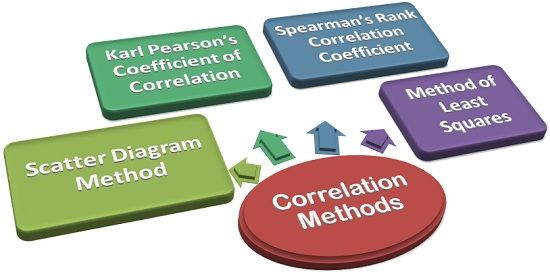Explain Different Methods of Studying Correlation
Linear and non-linear correlation. The Scatter diagram method is a simple representation that is popularly used in commerce and statistics to find the correlation between two variables.
Correlational Research Designs Types Examples Methods
Think about an event that you find interesting.

. 2 Spearmans Coefficient of Correlation Method or Rank Difference Method. Karl Pearsons Coefficient of Correlation Method. Correlation is a term in statistics that refers to the degree of association between two random variables.
In ease of ungrouped data of bivariate distribution the following three methods are used to compute the value of co-efficient of correlation. This measure is used when there is an immediate requirement for a direction to be understood. A positive correlation means that both variables change in the same direction.
A correlation coefficient is a descriptive statistic. A correlation reflects the strength andor direction of the association between two or more variables. It is the simplest method to learning the Correlation of the two variables as the values of each variable are designed graphically suing dots thus attaining as.
Spearmans Rank Order Co-efficient of Correlation. A method of checking correlation using sample standard deviations of x and y. The Pearson correlation is the most commonly used measurement for a linear relationship between two variables.
Therefore when one variable increases as the other variable increases or one variable decreases while the other decreases. Youre not implying A causes B or vice versa. Different Methods of establishing Correlation between variables.
A zero correlation means theres no relationship between the variables. 1 Karl Pearsons Coefficient of Correlation Method or Karl Pearsons method. Correlation coefficients summarize data and help you compare results between studies.
Karl Pearsons coefficient of correlation. The stronger the correlation between these two datasets the closer itll be to 1 or -1. 1 Scatter Plot 2 Kar Pearsons coefficient of correlation 3 Spearmans Rank-correlation coefficient.
Pearsons Product Moment Co-efficient of Correlation. Here there will be a relation between two or more variables being involved. So the correlation between two data sets is the amount to which they resemble one another.
There are three possible results of a correlational study. A positive correlation is a relationship between two variables in which both variables move in the same direction. Q1 If a change in the value of one variable causes a simultaneous change in the other variable in the same or opposite direction it is termed as ______________.
This is a measure used when there is a requirement to optimize and explain the numerical response provided from y to x. Even though the terms are similar explain the different between ethnography and ethnocentrism. Positive and negative correlation.
Coefficient of correlation r is obtained by dividing the product of values of covariance of the two series by the product of their standard deviations. This is the best mathematical method of determining the correlation. Scatter diagram method.
Whether the correlation between the variables is linear or non-linear depends on the constancy of ratio of change between the variables. We shall consider the following most commonly used methods. A negative correlation means that the variables change in opposite directions.
Explain the different between correlation and causation. Give your own example of each. Spearmans rank correlation coefficient.
3 Concurrent Deviations Method. Types of Correlation In Research Methodology of the Management Correlation is broadly classified into six types as follows. Spearmans Rank Order Co-efficient of Correlation.
Simple multiple and partial correlation. A case study may use a combination of methods to study one thing or event. Correlation is a measure of the strength of association between two variables.
Another method of checking correlation using standard deviations of the. For example from the values of two. Learn about the definition types analysis and examples of correlation and understand the meaning of the.
The 3 methods of data collection in correlational research are naturalistic observation method archival data method and the survey method. 1 Positive Correlation 2 Negative Correlation 3 Perfectly Positive Correlation 4 Perfectly Negative Correlation 5 Zero Correlation 6 Linear Correlation Positive Correlation. There are three types of correlation.
If A and B tend to be observed at the same time youre pointing out a correlation between A and B. One is taken along the horizontal x-axis and the other along the vertical y-axis. 1 Scatter Plot Scatter diagram or dot diagram.
Here it helps to understand how y can influence x by. Give your own example of each. In this method the values of the two variables are plotted on a graph paper.
That means that it summarizes sample data without letting you infer anything about the population. A positive correlation a negative correlation and no correlation. Linear and Non-Linear Curvilinear Correlation.
A correlation coefficient is a bivariate statistic when it summarizes the relationship between two variables. This is the simplest method of studying the relationship between two variables. The most popular and commonly used methods of studying correlation between two variables are.
These two variables are plotted along the X and Y axis on a two-dimensional graph and the pattern represents the association between these given variables. The correlation is said to be linear when the amount of change in one variable to the amount of change in another variable tends to bear a constant ratio. This type of correlation is used to determine the monotonic relationship or association between two.

What Are The Methods Of Determining Correlation

Finding The Correlation Coefficient Using Pearson Correlation And Spearman Rank Correlation Spearman Pearson Mathematics
No comments for "Explain Different Methods of Studying Correlation"
Post a Comment